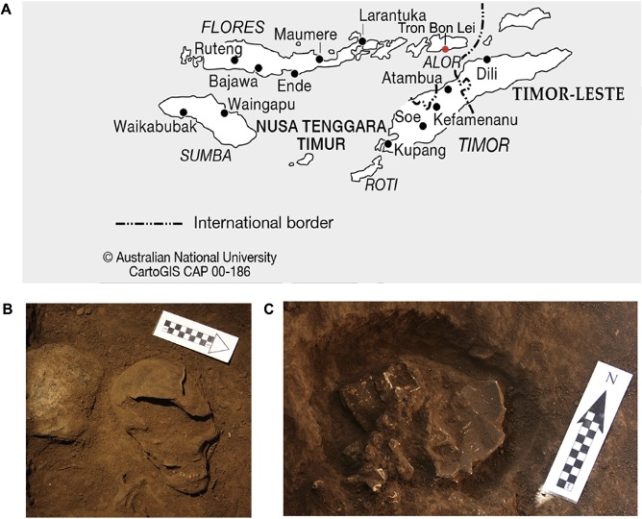Three skeletons found in a rock shelter adorned with red rock art reveal burial rituals of early humans who followed well-trodden paths through Indonesia's Lesser Sunda Islands.
Some clues about patterns of migration of early humans making their way southward were provided by the discoveries from Alor Island.
"Burials are a unique cultural phenomenon to investigate waves of migration through the terminal Pleistocene to the Holocene period in Southeast Asia," says archaeologistSofia Samper-Carro.
Southeast Asian burial sites offer a wide range of social expressions related to the deposition of the deceased, according to a paper by Samper-Carro and colleagues.
South East Asia is thought to be a melting pot of ancient humans who crossed paths and interbred in a landscape that was different during the last ice age.
After crossing through Wallacea, skilled mariners were able to travel to Australia, which was part of a larger land mass called Sahul.
It has been difficult to figure out which way people made those migrations.
Samper-Carro and colleagues began to piece together a more complete picture of modern humans moving through the islands of southeast Indonesia.
There were four waves of migrations through the Lesser Sunda Islands, which included Flores, according to comparative analyses.
A human skull and fish hooks that were more than 12,000 years old were found in the first excavations.

There was more to this tale. Four years after they returned to the site, they found two more bodies, one on top of the other, buried in different places.
The first skeleton, which was dated to around 7,500 years ago, was laid in a grave covered in shell and rock. A 10,000-year-old skeleton was laid to rest in a seated position in a circular grave filled with shells.
The original 12,000-year-old skull was located below that. The researchers thought that the woman was small and that it reflected a genetically isolated population on the islands.
There was a hook on the left side of the female skeleton. The age of the remains was confirmed using this adornment.
They suspect that the burials show shifts in social behaviors of modern humans and that they have been using the rock shelter on Alor Island as a burial site for thousands of years.
Recent discoveries of multiple migratory routes through the islands of Wallacea could be related to the three unusual burials.
It is possible that early humans exchanged cultural information as they migrated from mainland to southeast Asian islands. It is1-65561-65561-65561-65561-65561-65561-65561-65561-65561-65561-65561-65561-65561-65561-65561-65561-65561-65561-65561-65561-65561-65561-65561-65561-65561-65561-65561-65561-65561-65561-65561-65561-65561-65561-65561-65561-65561-65561-65561-65561-65561-65561-65561-65561-65561-65561-65561-65561-65561-65561-65561-65561-65561-65561-65561-6556
The remains are being analyzed for genetic and diet clues. Evidence of different migratory groups that gave rise to modern humans is expected to be revealed by genetic profiling.
The team concludes, "These future efforts will provide us deeper insights to interpret the lifeways of communities in mainland and island Southeast Asia during the last two million years."
The research was published in a peer reviewed journal.